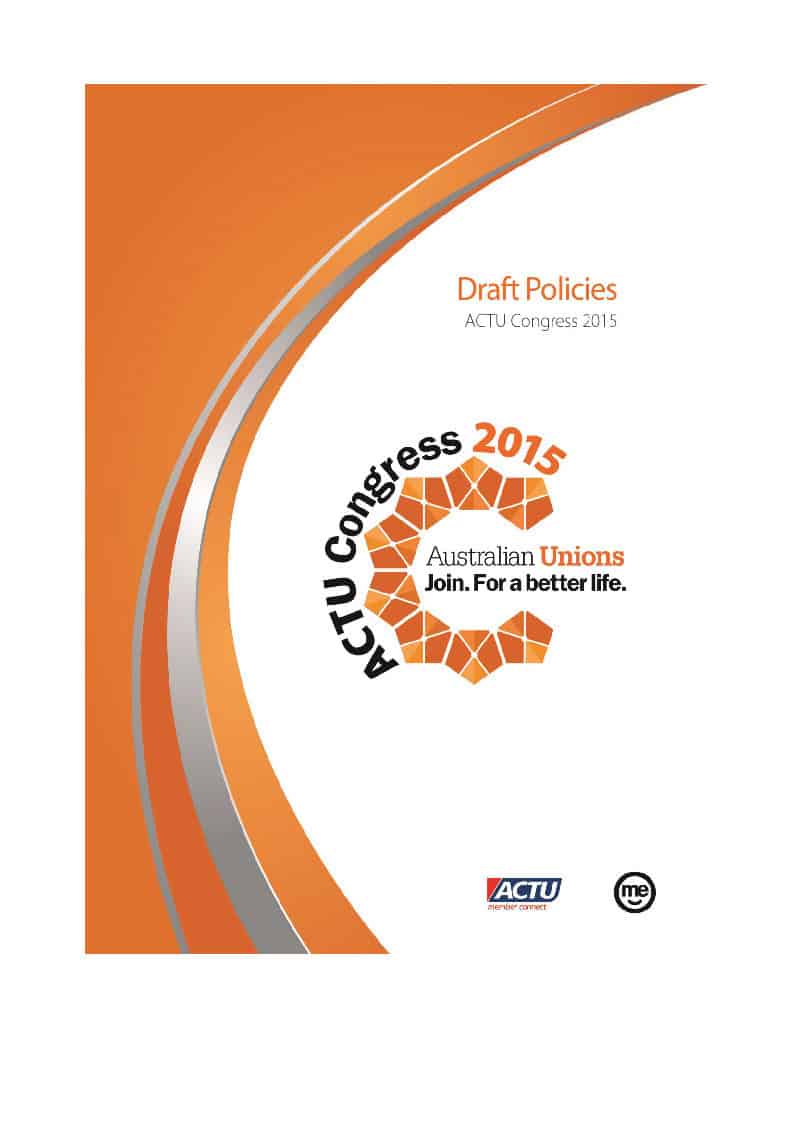The last three of Radio National’s WorkLife podcasts have been uploaded. Episode 4, focusses on occupational health and safety (OHS) and is based around interviews with myself, Kevin Jones, and Professor Niki Ellis. Continue reading “WorkLife podcast addresses OHS”
Tag: Workplace Bullying
ACTU Congress’ draft OHS policies deserve serious analysis
 The Australian Council of Trade Unions (ACTU) commences its 2015 Congress this week. Each year around 800 trade union delegates meet to discuss changes to policies and to develop or refine strategies. This year the ACTU released its draft policies publicly prior to the Congress. These policies have a long and strong historical and industrial relations context. Occupational health and safety (OHS) is an important part of these policies and should spark discussions in the union movement and the OHS profession.
The Australian Council of Trade Unions (ACTU) commences its 2015 Congress this week. Each year around 800 trade union delegates meet to discuss changes to policies and to develop or refine strategies. This year the ACTU released its draft policies publicly prior to the Congress. These policies have a long and strong historical and industrial relations context. Occupational health and safety (OHS) is an important part of these policies and should spark discussions in the union movement and the OHS profession.
Early in the document, the ACTU states its “bargaining agenda” in which is included
“better work, life and family balance.” (page 7)
Curiously, the ACTU has chosen “better” rather than “safe”. Better is a more inclusive term but harder to define. Better for whom? Better could be better paid or more secure or safer.
Trade unionists often see OHS as being monitored and enforced through the mechanism of the Health and Safety Representatives (HSRs) and would argue that OHS is throughout all the draft policies due to the HSR role but there are more workplaces in Australia without HSRs than with and it is worth considering the policies as independent from the HSR structure, if that is possible..
Don’t mention workplace bullying
Victoria’s Premier Daniel Andrews is involved in a, currently minor, political drama after he decided to stand down his Small Business Minister, Adem Somyurek, after allegations of workplace bullying. The drama is in its early days but some of the decisions and media comments are worthy of analysis, particularly as Premier Andrews seems to be avoiding using the term, workplace bullying.
The facts seem to be that the Minister’s Chief of Staff, Dimity Paul, complained to the Premier about Somyurek’s “intimidating, aggressive and threatening” behaviour. The Premier stood the Minister down after a formal complaint was made to the Department of Premier and Cabinet which has generated an investigation.
This allegation has a lot of political connections as described in an article in The Age newspaper written by Farrah Tomazin, but there is little doubt that the allegation comes under the definition of workplace bullying as there have been mentions of a “pattern of behaviour” by the Minister. Tomazin wrote
“The alleged misconduct …. is said to have taken place over the past few months, and relates to a number of employees in his ministerial office…”
Everyone wants a quick fix – OHS is no different
One of the professional disciplines that has had the biggest impact on occupational health and safety (OHS) management in Australia has been sociology but that influence seems to be waning as it fails to compete with the managerial imperative of short-termism and the quick fix.
This demand for a quick fix is partly a result of the increased sensitivity to reputational damage of both the organisation and the executive. This can be seen by the increasing attention to apparent solutions to safety problems of the individual worker, for instance, resilience training which is primarily about the individual toughening up. Neuroplasticity has entered OHS by saying that the individual can reconfigure their brain to, somehow, work more safely. Of course, the ultimate short-term solution to most workplace problems has existed for years – sack the worker.
All of this denies the organisational influence on workers, managers and executives because organisational change is hard and it takes time, both are challenges that do not fit with modern expectations of business.
One of the clearest examples of the inability or unwillingness of executives to improve OHS through organisational change is the management of
Productivity Commission looks at workplace bullying – not really
The Australian Government has announced an inquiry into workplace relations through the Productivity Commission (PC). The most obvious occupational health and safety (OHS) element of this inquiry relates to workplace bullying which is discussed in the fourth of five issues papers released in January 2015. However the purposeful separation of workplace bullying actions through the Fair Work Commission (FWC) from actions in other sectors, such as OHS regulators, limits the potential impact of the inquiry on this issue.
The PC issues paper acknowledges the lack of the anticipated avalanche of anti-bullying applications and accepts that the structure of the FWC process may be partially responsible. This lack of applications, an issue discussed
New workplace bullying evidence
There have been many claims of a workplace bullying epidemic in Australia but there has always been a lack of evidence. Research has been targeted into specific industry sectors or regions but broad ranging studies have been few. This lack of evidence was a major frustration for the Parliamentary Inquiry into Workplace Bullying that concluded in late 2012. However useful evidence is beginning to appear.
A recent edition of the Journal of Health Safety and Environment included a report (subscribers only) entitled “The prevalence and nature of bullying: A national study of Australian workers”. The authors, Dr Sarven McLinton, Maureen Dollard, Michelle Tuckey and Tessa Bailey, wrote that the study
“… shows that nearly 7% of Australian workers reported bullying and harassment in the past six months.” (page 283)
